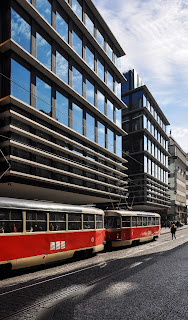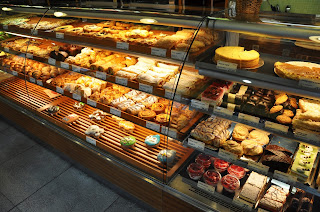They say that the best way to appreciate art is through immersion. If you want to understand the different styles of painting, don't look at a single painting, go to a museum. In terms of architecture, that is what Prague is; one giant museum of architecture. I make no claim to be an expert in architecture or design, but when immersed in it, I became a quick study, as I think many visitors to Prague become.
Fortunately, Prague did not suffer the large scale damage that many European cities did during World War II and much of its architecture is in tact and amazing. As you walk the streets of Prague you get a wide ranging cross of amazing styles.
Romanesque
 |
| St. Cross Rotunda |
The first style is Romanesque, which is, as the title would indicate, indicative of the styles of ancient Rome. It was common during the Middle Ages and is recognizable because of its round, thick walls, arched windows, and simple, symmetrical designs. The St. Cross Rotunda is an excellent example of a Romanesque rotunda.
The legend surrounding the St. Cross Rotunda is that the spot where it stands used to be the center of a small pond. When a young girl defied her parents by believing in Christ, her parents crucified her and threw her in the pond, cross and all. Afterwards, during a storm, the cross rose up and it was regarded as a sign from God. Supposedly, during a restoration in the 19th Century, a rotted wooden cross was found in the foundation of the rotunda.
Ghost stories not withstanding, the St. Cross Rotunda is a wonderful little treasure lost in the winding, ornate streets of Old Town, and finding it is typical of any walk through Prague in that you never know what will be just around the next corner.
Gothic
 |
| Church of Our Lady before Tyn |
You don't have to look very hard in Prague to find an amazing example of Gothic architecture. One glance at the skyline will reveal a multitude of spires reaching up to the heavens. The gothic cathedrals of Europe are where you can find the style expressed the most profoundly, and while Prague has several gothic cathedrals, most notably St. Vitus Cathedral which sits at the heart of Prague Castle, I find that the Church of Our Lady before Tyn is the most striking in terms of gothic style.
Tyn Church looms over the main public square in Old Town, across from the famed Astronomical Clock. The gothic period itself was a rather long one lasting from the 12th to 16th Century, and Tyn Church was constructed in the second half of this period (construction was completed in the 15th Century) and is therefore considered "late gothic."
The unmistakable signature buildings of the city: Tyn Church, St. Vitus Cathedral, and the mighty guard towers of Charles Bridge each constitute a gothic architectural masterpiece that will never be forgotten.
Renaissance
 |
| The House at the Minute |
The gothic style was eventually supplanted by the Renaissance style, which drew heavily from ancient Greek and Roman styles. The Renaissance style often included domes, columns and niches, it also is typified by the use of decorations on the façade of a building, often depicting Greek or Roman mythology. One good example of this is The House at the Minute.
There is so much going on in the main town square in Old Town that it is easy not to dwell on this ornate building right next to the Astronomical Clock for long, but it is worth the time. Aside from the gorgeous and elaborate decorations on the outside of the building, The House at the Minute also has the historical significance of being the childhood home of famed writer Franz Kafka, whose family lived on the second floor from 1889-1896.
Baroque
 |
| St. Nicolas Church (photo courtesy of Ursa Davis) |
The Renaissance was followed by the Baroque movement. And while the Renaissance style was driven especially by the Italian nobility, the Baroque movement was meant to showcase the size and triumph of the Catholic Church. The ornate embellishments were meant to be a statement of wealth and power and are noticeable because of the way they experiment with light and shadow.
Rococo
 |
| Kinsky Palace |
Often referred to as "late-baroque," the Rococo movement is, for lack of a better description, Baroque on overdrive. It began as a French style, that artists began using to break away from the rigid rules that had begun to surround Baroque. The source of the term Rococo is not totally clear, but it is thought to refer to a popular style of gardening at the time which was centered around pebbles and shells, and is therefore a combination of the French
rocaille (stone) and
coquilles (shell).
Rococo buildings like the Kinsky Palace feature shell like curves and asymmetrical scrollwork. They are also notable because each room is intended to be a total work of art, including painting, furnishings, and interior design.
Moorish Revival
 |
| Jubilee Synagogue |
During the middle of the 19th Century, Europe and America became very enamored with various design forms which were seen as exotic. This gave rise to the Moorish Revival movement which became popular in theaters and houses of worship of the time.
One lovely example of this is the Jubilee Synagogue. The synagogue features the noticeable keyhole arches and layers of colorful stone which would strongly classify it as Moorish Revival, and the inside is a lovely mix of Moorish Revival and Art Nouveau.
Art Nouveau
Because of the huge influence of the Alphons Mucha, the father of the Art Nouveau movement, Prague is awash in Nouveau buildings. The most famous example of Art Nouveau in Prague, or maybe anywhere, is the Municipal House, which features restaurants, galleries and a concert hall all immaculately crafted in Nouveau touches, many from Mucha himself.
Like Rococo, Art Nouveau was intended to be a complete artistic experience not just a few decorative touches but the entire interior and exterior design is included. Along with its signature flowing curves and arcs, Nouveau also includes many natural elements such as grasses, insects trees and birds into its design aesthetic.
Even though the Municipal house stands as an Art Nouveau masterpiece, one of the best places to see Nouveau architecture is the houses along the Vltava River. It is a lovely walk filled with one gorgeous building after the next on one side and the skyline featuring Prague Castle and the St. Vitus Cathedral on the other.
Cubism
 |
| House of the Black Madonna |
As an art style, cubism was generally short lived, and often gets associated with Spanish painters such as Pablo Picasso, but it is not as well known that Czech artists and sculptors played an important role in the movement as well, and that Prague was a cultural and artistic center before the start of the First World War.
Well known cubist architects include Pavel Janak, Josef Gocar, Vlastislav Hofman, and Josef Chochol, and for an art movement that is so noticeably short, the body of work, and impact on the face of Prague of those men is profound.
The finest example of the cubist's influence is Josef Gocar's signature work, The House of the Black Madonna. One of the things that makes this building so striking is the baroque style buildings that surround it, making its stark lines even more apparent. Another interesting point is the Grand Orient Café on the ground level is the finest surviving example of a cubist interior anywhere in the world.
Rondocubism
 |
| Adria Palace |
This take on the cubist movement is not only rare, but also, almost unique to Prague. Rondocubism refers to cubism that employs the use of some rounded surfaces. Josef Zasche and Pavel Janak collaborated on the a stunning Adria Palace which is a must see for anyone interested in architecture.
Soviet Era
Many of the Soviet Era buildings have a distinct stark gray simplicity to them which can be appealing to some in an aesthetic sense, but for most they stand out as strong emotional reminders of a contentious time. When they are adorned with sculptures or decorative elements, they are almost always of proletarian figures. And though the soviet era buildings in the heart of the city can be quite nice, as that they were built to house dignitaries, the vast majority of soviet era architecture can be found on the outskirts of the city in the form of housing projects that are little more than concrete jungles.
High Tech
Whether it is called High Tech, Late Modernism or Structural Expressionism this style, which took favor in the mid to late 1970's is known for its glass walls, clean lines, steel frames and prefabricated components.
While this is a functional, signature look for a lot of commercial districts at the heart of modern cities, especially in the United States; here in Prague it feels like a missed opportunity to do something more avant garde. Although, surrounding these structures with buildings of such a diverse stylistic backgrounds is a good reminder that contemporary High Tech structures are a design too, and in a generation they too will look dated, and representative of a bygone era.
Post 1989
 |
| Dancing House |
The iconic, bold, and memorable Frank Gehry building called The Dancing House proves the commitment of Prague to continuing a tradition of pushing the architectural boundaries. Dancing House is also commonly referred to as Fred & Ginger.
The place where the Dancing House currently stands is on a prime spot along the Vltava River, and had remained open since World War II, when American and British bombers accidentally bombed Prague mistaking it for Dresden. It wasn't until 1996 that the city allowed Gehry to fill the opening.
I have a personal fascination with the architects Frank Gehry, and as I have traveled around the world I have personally been to a number of his iconic buildings. My home town of Seattle, Washington houses the EMP at the Seattle Center, and we have visited MIT's Stata Center in Cambridge, Massachusetts, and The Walt Disney Concert Hall in Los Angeles, California. I never cease to be amazed by his work.
































